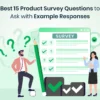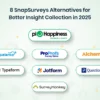In the realm of business success, understanding and enhancing customer satisfaction is the linchpin. A pivotal tool in achieving this goal is the customer experience app, a technological marvel that facilitates the measurement and improvement of customer satisfaction. In this comprehensive guide, we explore eight quick steps to effectively measure and elevate customer satisfaction, utilizing the power of a customer experience app.
Why Measure Customer Satisfaction?
CSAT goes beyond mere gut feelings. It provides quantifiable data, revealing areas of excellence and opportunities for improvement. Here’s why measuring CSAT is vital for your business:
- Uncover hidden issues: Dissatisfied customers often stay silent. CSAT surveys give them a voice, revealing hidden frustrations before they escalate.
- Boost customer loyalty: A positive CSAT score indicates happy customers, leading to increased loyalty, repeat business, and positive word-of-mouth referrals.
- Improve product and service offerings: CSAT insights can guide product development, service enhancements, and marketing strategies to better meet customer needs.
Boost Customer Satisfaction and Fuel Your Growth with piHappiness!❤️
Get Started Now!
Empower your team: Sharing CSAT data with your team fosters a culture of customer-centricity, motivating everyone to deliver exceptional experiences.
8 Quick Steps to Measuring Customer Satisfaction:
Ready to unlock the secrets of happy customers? Follow these 8 quick steps to implement a robust CSAT measurement system:
1. Define Clear Objectives for Customer Satisfaction Measurement:
Begin by establishing clear objectives for measuring customer satisfaction. Understand what aspects of the customer experience you aim to evaluate, whether it’s product satisfaction, service quality, or overall brand perception. Setting specific goals ensures a focused and actionable approach.
- Customer Satisfaction Score (CSAT): Measures satisfaction with a specific interaction (e.g., customer service call, product purchase). Use a simple scale (1-5, Very Dissatisfied to Very Satisfied).
- Net Promoter Score (NPS): Measures customer loyalty and likelihood to recommend your brand. Ask “How likely are you to recommend us to a friend or colleague?” on a 0-10 scale.
2. Select the Right Customer Experience software:
Choosing the right customer experience app is paramount. Look for features such as user-friendly interfaces, customizable survey options, multichannel integration, and real-time analytics. A robust app forms the foundation for accurate and efficient customer satisfaction measurement.
. Choose Your Channels:
- Post-interaction surveys: Send surveys immediately after a specific interaction (e.g., email, pop-up on website, SMS).
- Surveys: Email, SMS, online forms, or in-app surveys offer flexibility and reach.
- Customer feedback tools: Dedicated platforms provide advanced features for collecting and analysing feedback.
- Social media: Monitor brand mentions and engage in direct conversations with customers.
- Customer support channels: Analyse support tickets and calls to identify recurring issues and pain points.
- Periodic surveys: Schedule regular surveys (e.g., quarterly) to capture overall satisfaction and track trends.
- Embedded feedback options: Integrate feedback tools within your website, app, or customer service platform for real-time insights.
3. Design Targeted Customer Satisfaction Surveys:
Craft surveys that are concise, relevant, and aligned with your objectives. Use the customer experience software to design targeted surveys that address specific touchpoints in the customer journey. Ensure a balance between quantitative data (such as ratings) and qualitative insights (comments and suggestions).
- Keep it concise and relevant: Aim for 5-10 questions, focusing on key touchpoints.
- Use clear and neutral language: Avoid jargon and leading questions.
- Offer open-ended questions: Gather qualitative data for deeper understanding.
- Provide multiple response options: Make it easy for customers to respond.
4. Implement Customer Satisfaction Score (CSAT) Surveys:
Integrate CSAT surveys into your customer experience app. CSAT surveys typically involve a simple question about satisfaction levels, often on a scale. Analysing CSAT scores provides a snapshot of customer sentiment after specific interactions, allowing for quick assessments and improvements.
- Utilize data visualization tools: Create charts and graphs to identify trends and patterns.
- Segment your data: Analyse by customer type, product/service, or interaction for targeted insights.
- Set benchmarks and track progress: Monitor your CSAT scores over time to measure improvement.
5. Gauge Loyalty with Net Promoter Score (NPS):
Incorporate NPS surveys to gauge customer loyalty. The NPS question, “How likely are you to recommend our product or service to a friend or colleague?” categorizes respondents into Promoters, Passives, or Detractors. This classification provides insights into overall customer loyalty and advocacy.
Why Use NPS?
NPS offers a multitude of benefits:
- Simplicity: The single-question format is easy to understand and implement, making it accessible to customers and businesses alike.
- Actionable insights: NPS provides a clear picture of your customer base, allowing you to identify areas for improvement and focus your efforts on nurturing promoters and converting passives and detractors.
- Benchmarking: NPS allows you to compare your score against industry benchmarks and track your progress over time.
- Employee engagement: NPS can be used to measure employee sentiment towards the company, fostering a culture of customer-centricity.
6. Leverage Real-time Analytics for Immediate Insights:
Harness the power of real-time analytics offered by your customer experience. Immediate insights into survey responses enable prompt identification of trends and areas for improvement. Swift actions based on real-time data contribute to an agile and customer-centric approach.
- Address negative feedback: Respond promptly and take steps to resolve issues.
- Share positive feedback: Celebrate successes with your team and highlight areas of excellence.
- Implement improvement plans: Use insights to improve processes, products, and service delivery.
7. Utilize Customer Experience softwares:
- Streamline data collection and analysis: Look for apps that offer survey tools, reporting, and feedback management features.
- Personalize the feedback experience: Tailor surveys and communication based on individual customer data.
- Automate tasks: Save time and resources with automated survey scheduling and reporting.
8. Implement Continuous Improvement Strategies:
Customer satisfaction measurement is an iterative process. Use the data collected through the customer experience software to implement continuous improvement strategies. Address specific pain points, acknowledge positive feedback, and demonstrate a commitment to enhancing the overall customer journey.
- Make CSAT data accessible: Share insights with all departments to encourage a customer-centric approach.
- Reward employees for positive CSAT scores: Motivate your team to prioritize customer satisfaction.
- Celebrate customer success stories: Showcase the positive impact of happy customers on your business.
Customer Experience through App: Your Measurement Powerhouse:
Customer experience (CX) apps can be your powerful allies in measuring satisfaction. They offer features like:
- Automated surveys: Schedule and distribute surveys based on customer touchpoints.
- Real-time feedback: Get instant insights through in-app feedback tools and chatbots.
- 360-degree view: Unify customer data from various sources for holistic insights.
- Generate comprehensive reports to identify trends and prioritize actions.
Remember: Measuring CSAT is just the first step. The real magic lies in acting and continuously improving your offerings and interactions based on customer feedback. By implementing these 8 steps and leveraging the power of customer experience software, you can unlock the door to a world of happy customers and a thriving business.








